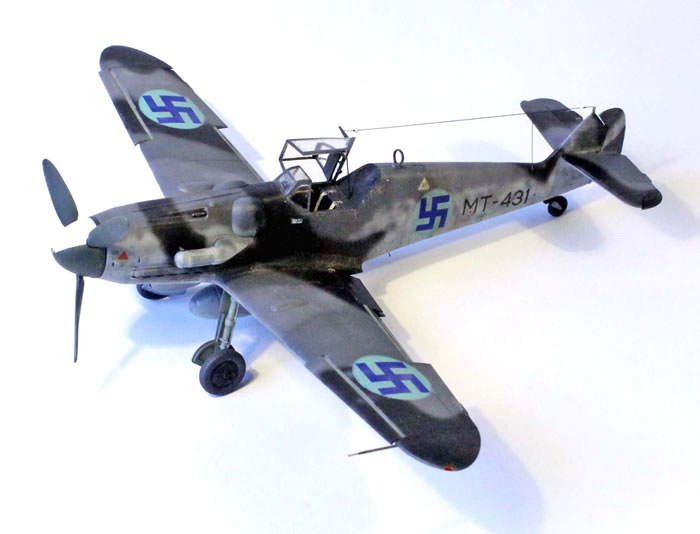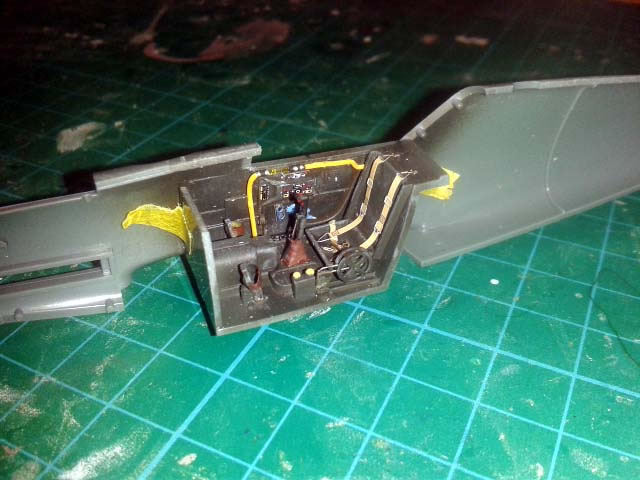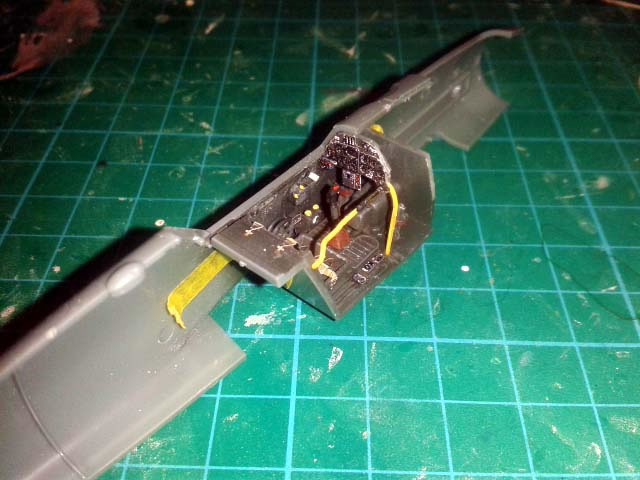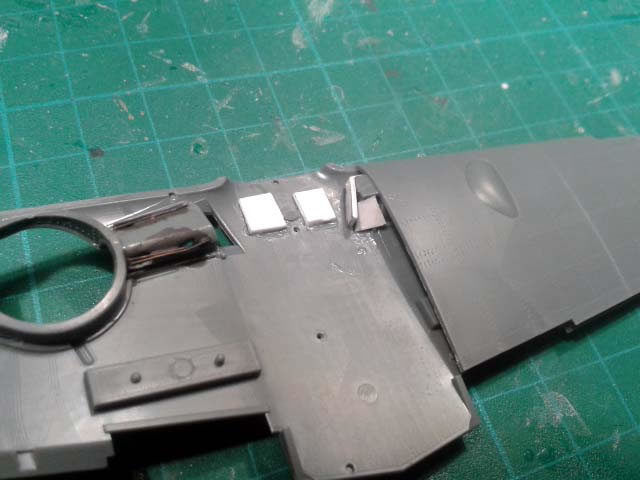Eduard's 1/48 scale
Messerschmitt
Bf 109 G-6
by Fernando Rolandelli
|
Messerschmitt Bf 109G-6
2/HleLev24; Utissa, late 1944 |

Eduard's 1/48 scale Bf 109 G-6 is available online from Squadron for only $39.99!
Background
The Finnish Air Force received its first Bf 109s in 1943. A total of 162 aircraft of this type were to be purchased and the first aircraft landed in Finland on 13 March 1943. In total, 159 aircraft were taken into service, as two G-6s and one G-8 were destroyed en route to Finland. Forty-eight of these were G-2s, 109 were G-6s and two were G-8s. The Bf 109 is still the aircraft type that has served in the largest numbers in the Finnish Air Force. The aircraft was nicknamed Mersu in popular speech (the same as the nickname for Mercedes-Benz cars, whose parent company Daimler-Benz produced the Bf 109 engine) and carried the designation MT and a 3-digit identification number.
Having used them to great effect against the Soviets (with 667 victories claimed against 34 combat -plus 16 operational- losses), after the September 1944 Armistice they were turned against their former allies, in the so called “Lapland war”. During this, the very promintent Yellow Eastern Front markings were obliterated, making the aircrafts duller. Some receive a supplementary camouflage in Black, prefiguring the later Olive Green/Black that they would receive in time.
The Kit
This is the latest Eduard 1/48 109G-6, in its “overtree” incarnation. After the sorry saga of the previous kit, Eduard made some corrections to the moulds (considered enough by some and a bit short of the mark by others) and made a new kit available.
There were many talking about what would happen to all the modellers who had bought the previous kit, and the action taken by Eduard was allowing for a discount coupon to any one proving his purchase of the old kit.

More important than that, the “overtrees” variant was made permanently available (while in previous kits it was a temporary allowance), which is a great incentive for buying the kit (“overtrees” are really cheap, and who doesn’t have aftermarket detail sets and decal sheet by the pound for 109G-6s) PE “overtrees” were also available, these being the same sets in the Profi kit, as were stencil decals. That I would call a proper way of socializing and making do for the misshap.
Therefore, I got a couple of “Overtree” kits, together to the PE. I had the “Inscale” decal sheet for Finnish 109Gs, which provided all the markings including the stencils, which should be in Finnish language.
The kit assembles very well, just a bit short of “falling together” class. The cockpit looks a bit flat, but is fairly complete and can be furnished with some of the PE parts available; instrument panel fitted very well, and there are faces for the many fittings and devices. PE pedals, for instance, are far oversized and were left out.

The throttle assembly, a prominent part in any WW2 single seat fighter, is inexplicably moulded to the sidewall and very flat. I used a PE part from a set meant for the Hasegawa kit.

Exhausts stubs look a bit wide, and the opening in the nose frighteningly wide when the fuselage is still on the sprues. Compared to the Zvezda F kit, if we take the “wider” set of exhausts (there are two in that kit) the difference is small, though still noticeable. When finally mounted, they look not nearly as terrible as you had imagined before.
Landing gear bays deserved some attention. The holes in the leg bay are closed, and I opened them; conversely, the back of the leg mounts are open, and I closed them with plastic strips and pieces reminiscent of the operations made to old Frog kits.

Legs are a bit longish, but they are set deep into the bays so the final stance of the model is the same as, say, Hasegawa’s. The wells themselves are well detailed. I secured the diedhral with some tape.
All flying surfaces and radiators’ flaps being separated I took the chance to deflect them all, if only just a bit. They all behaved correctly.
My model should have the sand filter (very useful in Finland; I guess that the earth after defrozing is reduced to dust), but the one in the model is constructed from a plastic part with PE meshes. Now, those meshes are not in the PE set for this kit (no airframe depicted carries it) I therefore resorted to the PE set in the “old” kit, which lead to some interesting discoveries (more to follow).
Painting
The scheme looks to have been the normal RLM74/75/76 to which the Finns have added the Black areas of their own late-war Olive Green/Black forest camouflage.
This “mixed” camouflage can be seen in a few machines, MT-499 is another example.
All paints are Xtracrylixs applied over Alclad Grey Primer and a heavy Burnt Umber preshade. All were applied freehand with a “mottle” effect to attain a degree of “weathering”. This was very successful on the light undersurface but not so on the uppers, were the effect is very subtle and the successive clear coats fade it away a great deal.
The effect of the overpainting of the upper “open style” Balkenkreuzen was mimicked by painting a few almost random RLM75 strokes onto the mainly 74 area. The obliterated Yellow Axis Ost Front markings were made by overpainting the area with denser RLM76, to mimick the “fresher” paint. The fuselage band was “re-applied” in 76 and “recamouflaged” in 74/75; the effect is still discernable if you look intently.
Decals
“72 Scale” decals, a Finnish specialist, were accurate and very good in density and colour. They even come with a full set of Finnish language stencils. They are a bit thick and tend to silver a bit. I used DACO set, resorting to the “Hot” fluid to persuade the most recalcitrant of them.
This is a good kit. Probably not a world beater such as their Spifire IX/VIII, but a good kit in all.
Looks quite accurate in shape. Fuselage is a couple of millimetres longer than Hasegawa’s, though the nose looks a bit fat compared to it (though the spinner plates are almost the same diameter, as well as Zvezda’s) and the fuselage sidewall looks a bit taller (but we know Hase’s is a bit on the slim side) It sits correctly; the model doesn’t “tiptoe” (though the leg struts have been reported to be a bit longish) Exhausts are a bit too wide, but that is more apparent in the unbuilt kit than in the finished model. Canopy is the same size as both Hasegawa and Zvezda.
Amazingly, all the small parts (two sprue-loads of them), the clear parts, the PE and the stencil decals are interchangeable with the “old” (and incorrect) kit. Even the spinner plate and the cockpit floor. I guess that was part of the compromise the guys at Eduard had to make to alter of the moulds, correcting them to some extent and still make it financially sound. All in all, it is a pleasant kit to build.
Sources
-
Suomen Ilmavoimen Historia 06, Messerschmitt Bf 109G”, Kalevi Keskinen, Kari Stenman, Klaus Niska; Tietoteos, Helsinki, 1976
-
“Messerschmitt Bf 109F/G &K Series. An illustrated Studio”, Prien and Rodeike, Schiffer Publication
-
“Messerschmitt Bf-109F – K. Development, Testing and Production”, Willy Radinger and Wolfgang Otto, Schiffer Publications (1999)
-
“The Messerschmitt Bf-109 In Action”, Squadron Signaal
Text and Images Copyright ©
2017 by Fernado Rolandelli
Page Created 9 March, 2017
Last Updated
9 March, 2017
Back to HyperScale Main Page
|
Home
| What's New | Features | Gallery | Reviews | Reference | Resource Guides | Forum |